|
Location: Mount Baigong,
Qinghai Province, China. |
Grid Reference:
. |
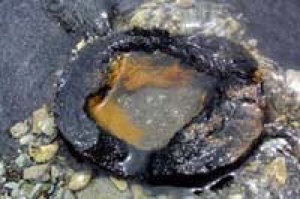
 Baigong Pipes:
(Reported 'Metal pipes' and 'Pyramid').
Baigong Pipes:
(Reported 'Metal pipes' and 'Pyramid').
The Baigong Pipes are reported to be associated
with a �pyramid� about 50 to 60 metres (160 to 200 feet high) built
on 'Mount Baigong'. The front of the �pyramid� is reported to contain
three caves. The mouths of the two smaller caves have collapsed.
Only the largest cave, which is 6 metres (18 feet) high, can be
entered (1),(2). Two Baigong Pipes have been reported from the largest cave.
One of these is described as being 40 cm (16 in) in diameter and
preserved as a reddish-brown �half-pipe�. Within the same cave,
another pipe-like feature of similar diameter was also found.
�Dozens� of upright pipe-like features, about 10 to 40 cm (4 to 16
inches) in diameter, were also found protruding from Mount Baigong
above the largest cave.
(Image
of the Baigong Cave and Surrounding 'Pyramid')
|
Mount Baigong ('Baigong' means 'Mount') |
It should be
immediately noted that the word 'Baigong' means 'Hill' in the
local dialect, so it isn't worth looking for 'Mount Baigong' on
any map. In addition, there is absolutely no evidence of a
pyramid anywhere, the 'pyramid' is actually an escarpment by
Toson Lake.
Near the foot of
an escarpment (Mt. Baigong) by Toson Lake lie three
caves, the largest and most accessible some eight meters high by
six meters deep. Inside, spanning from the roof to the back end
of the cave, runs a pipe 40 cm in diameter. Another one roughly
the same size runs into the earth from the floor, with just the
top protruding.
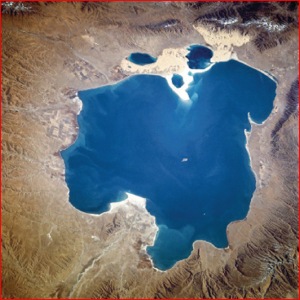 Additional Baigong Pipes
were found on shore and within Toson Lake, which lies 80 m
(260 ft) from the mouth of the largest cave. On the beach of
Lake Toson, about 40 m (130 ft) from the mouth of the
largest cave, apparently flat-lying, hollow, pipe-like features
were found. These reddish-brown pipe-like features range in
diameter from 2 to 4.5 cm (0.8 to 1.8 inch) and have an
east-west orientation. Another group of pipe-like features,
presumably vertical, either protrude from or lie just below the
surface of the lake. Additional Baigong Pipes
were found on shore and within Toson Lake, which lies 80 m
(260 ft) from the mouth of the largest cave. On the beach of
Lake Toson, about 40 m (130 ft) from the mouth of the
largest cave, apparently flat-lying, hollow, pipe-like features
were found. These reddish-brown pipe-like features range in
diameter from 2 to 4.5 cm (0.8 to 1.8 inch) and have an
east-west orientation. Another group of pipe-like features,
presumably vertical, either protrude from or lie just below the
surface of the lake.
(Note the
'Alien Grey' head in the water)
Associated with these
pipe-like features are "rusty scraps" and "strangely shaped
stones". Analysis of the "rusty scraps" by Liu Shaolin at a
local smelters reportedly found that they consist of 30 percent
ferric oxide and large amounts of silicon dioxide and calcium
oxide
(1)(2). Many other iron
pipes can be found scattered on sands and rocks. They run in an
east-west direction with a diameter between 2 and 4.5 centimetres.
They are of various strange shapes and the thinnest is like a
toothpick, but not blocked inside after years of sand movement.
Stranger still is that there are also some pipes in
the lake, some reaching above water surface and some buried below,
with similar shapes and thickness with those on the beach.
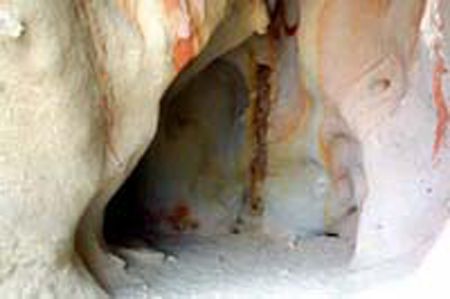
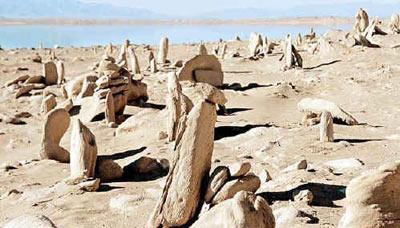
The cave
entrance: (Left), Surrounding 'Stones' (Right).
The Discovery:
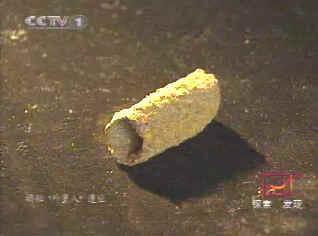 The pipes were first
discovered by a group of U.S. scientists on the trail of
dinosaur fossils, who reported them to the local authorities in
Delingha. They were ignored until a report, possibly one of six
made, by Ye Zhou, appeared in the "Henan Dahe Bao" (河南大河报 Henan
Great River News) in June of 2002. Soon after, Quin Jianwen, a
local official, discussed the pipe-like features with
journalists of the Xinhua News Agency on June 16, 2002. The
local government has promoted the pipe-like features as a
tourist attraction with road signs and tourist guides. The pipes were first
discovered by a group of U.S. scientists on the trail of
dinosaur fossils, who reported them to the local authorities in
Delingha. They were ignored until a report, possibly one of six
made, by Ye Zhou, appeared in the "Henan Dahe Bao" (河南大河报 Henan
Great River News) in June of 2002. Soon after, Quin Jianwen, a
local official, discussed the pipe-like features with
journalists of the Xinhua News Agency on June 16, 2002. The
local government has promoted the pipe-like features as a
tourist attraction with road signs and tourist guides.
In 2002, expeditions to
study the Baigong Pipes were reportedly planned. Anonymous
(2002a, 2002b) reported that a group of nine Chinese scientists
were to visit and study them in June 2002. A group of
researchers from the Beijing UFO Research Association were
making preparations to visit and study these pipe-like features.
This group was to be composed of 10 experts, 10 journalists, and
film team from CCTV (China Central Television).
(3)
News Article:
Chinese Scientists to Head for Suspected
ET Relics.
DELINGHA (QINGHAI), June 19, 2002 (Xinhuanet)
-- A group of nine Chinese scientists will go to west China's Qinghai Province this month
to closely examine the relics thought by some to have been
left by extraterrestrial beings (ET). It will be the first
time scientists seriously study the mysterious site near
Delingha City in the depths of the Qaidam Basin, according
to government sources with the Haixi Mongolian and Tibetan
Autonomous Prefecture, where Delingha is located.
The site, known by local people as "the
ET relics", is on Mount Baigong about 40 kilometres to the
southwest of Delingha City. On the north of the mountain are
twin lakes dubbed as the "lover Lakes", one with fresh water
and the other with salty water. The so-called ET relics
structure is located on the south bank of the salty lake. It
looks like a pyramid and is between 50 to 60meters high. At
the front of the pyramid are three caves with triangular
openings. The two smaller caves have collapsed and are
inaccessible but the cave in the middle is the biggest, with
its floor standing two meters above the ground and its top
eight meters above the ground.
This cave is about six meters in depth.
Inside there is a half-pipe about 40 centimetres in diameter
tilting from the top to the inner end of the cave. Another
pipe of the same diameter goes into the earth with only its
top visible above the ground. Above the cave are a dozen
pipes of various diameters which run into the mountain. All
the pipes are red brownish, the same colour as that of
surrounding rocks.
Scattered about the caves and on the bank
of the salty lake area large number of rusty scraps, pipes
of various diameters and strangely shaped stones. Some of
the pipes run into the lake. According to Qin Jianwen, head
of the publicity department of the Delingha government, the
scraps were once taken to a local smeltery for analysis. The
result shows that they are made up of 30 percent ferric
oxide with a large amount of silicon dioxide and calcium
oxide. Eight percent of the content could not be identified.
"The large content of silicon dioxide and calcium oxide is a
result of long interaction between iron and sandstone, which
meansthe pipes must be very old," said Liu Shaolin, the
engineer who did the analysis.
Alternative Hyptothesese:
So, how are we
to understand the presence of these pipes if they are not
man-made (or alien-made). The first thing scientists turned to are geological processes
in order to satisfactorily
explain them. The Chinese have put forth several such
hypotheses, including one involving the seepage of iron-rich
magma into existing fissures in the rock.
A
2003 article in Xinmin Weekly described how this might work.
Fractures caused by the uplift of the Qinghai-Tibet plateau
could have left the ground riddled with such fissures, into
which the highly pressurized magma driving the uplift would have
been forced. Assuming this magma was of the right composition
that, when combined with the chemical effects of subsequent
geological processes, we might very likely expect to see such
rusty iron structures in the local rock. But evidence of this
has never surfaced, and the Chinese dismissed this theory. They
also noted that the Qaidam oil field would not be able to exist
if there were active volcanism in the area as recently as
150,000 years ago.
It was their next theory that
has apparently led to a
satisfactory scientific explanation, and this theory involved the same
hypothesized fissures in the sandstone. But, instead of being
filled with iron-rich magma, the fissures could have been washed
full of iron-rich sediment during floods. Combined with water
and the presence of hydrogen sulphide gas, the sediment could
have eventually hardened into the rusty metallic pipe-like
structures of iron pyrite found today. This theory was not
fantastic, in part because there was no logical reason why the
sandstone might happen to be laced with pipe shaped fissures.
But the idea of flooding did make sense, given the geological
history of the Qaidam Basin.
Three years before
information was released about the cave
at Lake Toson, researchers Mossa and Schumacher wrote in the
Journal of Sedimentary Research about fossil tree casts in
Louisiana. They found cylindrical structures in the soil,
thermo-luminescence dated from 75-95,000 years ago. The chemical
composition of the cylinders varied depending on where and when
they formed and in what type of soil. The authors found that
these were the fossilized casts of tree roots, formed by
pedogenesis (the process by which soil is created) and
diagenesis (the lithification of soil into rock through
compaction and cementation). The result of this process was to
create metallic pipe-like structures, which by comparing the
descriptions offered by researchers, appear to be a perfect
match for the Baigong Pipes.
Similar pipe-like structures have been found
in the Jurassic sandstone of the South-western United States, as well
as in Citronelle formations in Louisiana. Researchers have concluded
that they were formed through natural processes.
The "Navajo Pipes":
Natural concretionary pipe-like features, which are quite similar to
the Baigong Pipes, occur in the Navajo Sandstone and other
sandstones of South-western United States in the form of hematite
"pipes". Hematite also occurs as other masses of diagenetic
"ironstone" that exhibit a wide and amazing range of bizarre shapes,
which can be described as both "strangely shaped stones" and "rusty
scraps". For example, strangely shaped stones, pipe-like features,
and other concretionary masses have been observed and described from
the Navajo and other Jurassic sandstones within Utah and adjacent
states. Brenda Beitler notes the presence of hollow "sub-horizontal
planar strata-bound pipes" and "vertical pipes", which have been
created by the precipitation of hematite within the Navajo
Sandstone. (4) In addition, the bleached sandstone seen in the
picture of the cave entrance is typical of sandstones, in which
natural pipe-like features have been found
(4)(5)
The pipe-like
features are the result of natural self-organization processes,
which occur during the precipitation of iron oxides within
sedimentary rocks.
The reported composition of the rusty scraps, 30 percent ferric
oxide and large amounts of silicon dioxide and calcium oxide, is
consistent with the hematite masses found in the Navajo and other
Jurassic sandstones in Utah and elsewhere in the Southwestern United
States. The ferric oxide and large amounts of silicon dioxide is
what a person would expect iron oxide cemented sandstone to consist
of. Calcite and other carbonate cements and concretions are
typically associated with the hematite masses in the Navajo and
other sandstones and sedimentary rocks.
(4)
The "Louisiana Cylinders":
Cylindrical structures very similar to the Baigong Pipes have also
been found protruding from outcrops of Pliocene Citronelle Formation
in the Florida parishes of Louisiana and in older Pleistocene
fluvial sediments within South-central Louisiana. These structures
are as much as 70 cm in diameter and 100 cm in depth. Detailed
studies of these cylindrical structures found that they were created
by the formation of ironstone rims around tap roots of pine trees by
soil forming processes. (6)
Arguments against the 'Tap-root' theory are that the pipes appear
to be straight and not curved. Also, they appear to be empty tubes.
(Prehistoric
China)
(OOPArts)
(Anomalous
Artefacts)
|

 Additional Baigong Pipes
were found on shore and within Toson Lake, which lies 80 m
(260 ft) from the mouth of the largest cave. On the beach of
Lake Toson, about 40 m (130 ft) from the mouth of the
largest cave, apparently flat-lying, hollow, pipe-like features
were found. These reddish-brown pipe-like features range in
diameter from 2 to 4.5 cm (0.8 to 1.8 inch) and have an
east-west orientation. Another group of pipe-like features,
presumably vertical, either protrude from or lie just below the
surface of the lake.
Additional Baigong Pipes
were found on shore and within Toson Lake, which lies 80 m
(260 ft) from the mouth of the largest cave. On the beach of
Lake Toson, about 40 m (130 ft) from the mouth of the
largest cave, apparently flat-lying, hollow, pipe-like features
were found. These reddish-brown pipe-like features range in
diameter from 2 to 4.5 cm (0.8 to 1.8 inch) and have an
east-west orientation. Another group of pipe-like features,
presumably vertical, either protrude from or lie just below the
surface of the lake.


 The pipes were first
discovered by a group of U.S. scientists on the trail of
dinosaur fossils, who reported them to the local authorities in
Delingha. They were ignored until a report, possibly one of six
made, by Ye Zhou, appeared in the "Henan Dahe Bao" (河南大河报 Henan
Great River News) in June of 2002. Soon after, Quin Jianwen, a
local official, discussed the pipe-like features with
journalists of the Xinhua News Agency on June 16, 2002. The
local government has promoted the pipe-like features as a
tourist attraction with road signs and tourist guides.
The pipes were first
discovered by a group of U.S. scientists on the trail of
dinosaur fossils, who reported them to the local authorities in
Delingha. They were ignored until a report, possibly one of six
made, by Ye Zhou, appeared in the "Henan Dahe Bao" (河南大河报 Henan
Great River News) in June of 2002. Soon after, Quin Jianwen, a
local official, discussed the pipe-like features with
journalists of the Xinhua News Agency on June 16, 2002. The
local government has promoted the pipe-like features as a
tourist attraction with road signs and tourist guides.